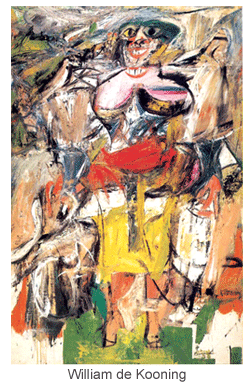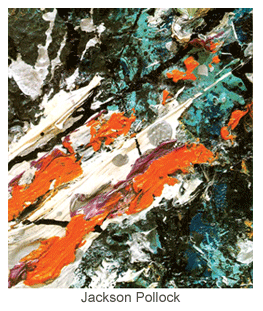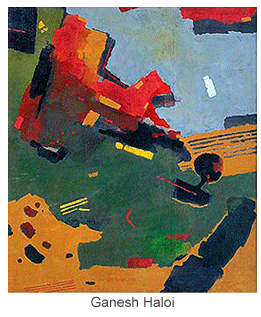- Prelude
- Editorial
- ...Where ever I stumble, let painting lie before me....
- ...Colour guides in its own direction...
- Abstract Art: Popular Myths and History
- Abstract Rhetoric:
- Ram Kumar: A transition from figurative to abstract
- I walk the line
- Exploring a twilight zone
- Articulating the Abstract voice from Madhya Pradesh
- Perception of Abstract in forms
- Confronting Cultures: The Dialectic of Abstraction in Bengal Art
- K.C.S. Paniker and his Words and Symbols
- Dialectics of Abstract Art and Its Indigenous Identity
- Between Ambivalence and Criticism: Why Abstraction?
- Notations and Rhythm in Space: Sushen Ghosh
- Victorian Era: Eclectic Furniture
- Patek Philippe : an overview
- The “Theme Pandals” of Durga Pujo: An Unexplored Discourse
- Musings on Music
- Butterflies in the stomach… still
- Contemporary Art Market Report 2009-10
- Artist Index and Statistics
- Auction Reports
- Recent works of Pavan kumar D. - In the Journey of Learning things
- Narrating “with a pinch of salt” Paintings of K.P.Reji
- Reclaiming an artist of true calibre
- Musings from Chennai
- An Annual Homage..
- Art Events Kolkata: September-October 2010
- Mumbai Art Sighting
- Art Bengaluru
- Unveiling the next in line
- Preview
- In the News
- Sotheby’s : Important Watches Hong Kong
ART news & views
Dialectics of Abstract Art and Its Indigenous Identity
Volume: 3 Issue No: 10 Month: 11 Year: 2010
The first half of the 20th century saw people's lives change in revolutionary ways that's quite unbelievable. Those who might have been relying on the hansom cab to travel to their business or workstation now had the automobile. Telephones and other technological developments eased the process of communication. Scientific and medical advances improved the lives of many, and in a way the world order was remarkably changed. And the two world wars stand as the signifying epitome of this century that changed the face of the world.  The art world also faced this change in havoc. The notion of the 20th century as a time of momentous change is mirrored by the fact that there were many emerging art movements and styles. Modernism is the broad and lasting term that overarches the art made at the beginning of the 20th century. And what made modernism or 20th century art so exciting and radical was that no one, single trend or course was followed. Rather, the 20th century art is a story of disparate movements and artists who, collectively and individually, approached their subject matter in a new spirit of freedom and autonomy; exploration and innovation are the key words of this age. This is that conjuncture of history when Emil Nolde and Max Bekmann emerged as German Expressionists and later we saw Jackson Pollock and William de Kooning as Abstract Expressionists.
The art world also faced this change in havoc. The notion of the 20th century as a time of momentous change is mirrored by the fact that there were many emerging art movements and styles. Modernism is the broad and lasting term that overarches the art made at the beginning of the 20th century. And what made modernism or 20th century art so exciting and radical was that no one, single trend or course was followed. Rather, the 20th century art is a story of disparate movements and artists who, collectively and individually, approached their subject matter in a new spirit of freedom and autonomy; exploration and innovation are the key words of this age. This is that conjuncture of history when Emil Nolde and Max Bekmann emerged as German Expressionists and later we saw Jackson Pollock and William de Kooning as Abstract Expressionists.
In the West, the inception of abstract art took place in the first half of the 20th century with Piet Mondrian who led to the development of pure abstraction. It was a journey from landscape painting to abstraction that encompassed an early struggle with the mystical principles of theosophy, which claimed an intuitive understanding of divine nature. In the latter part of the century when Pollock started inclining towards abstract art, the period was post World War II and Abstract Expressionism began to take roots primarily in the cities of New York and San Francisco. One of the main issues related to the advent of abstract art during the onset of the 20th century was not just the search for and development of a new language in art but the defence against the threat of modern technology. With the advancement of photography as an accepted medium of fine art in its own right, painters were compelled to rethink, and come up with a language that was alien to photography. Or in other words it became immaterial for audience to appreciate an artist's skill anymore for capturing naturalism through paintbrush that photography could do in much less time with far more perfection. And hence gradually, artists struggled to find their own refuge that in turn led to the plural nature of art forms, language and movements in the 20th century.
Well, this was precisely the scenario in Europe and America related to modernism and the birth of abstract art in the 20th century. For India the situation, socio-cultural reality and determining factors were quite different. As in the beginning of the 20th century, it was the inception and rise of the Bengal School to formulate and emphasise on the indigenous discourse and language to counter the European practices of art. But during the latter half of the 20th century things gradually changed, and there was a lot of appropriation and assimilation of thoughts, ideas, languages and discourses from Europe and America in the Indian aesthetic panorama. In the similar flow, abstract art too formed niche in the Indian subcontinent through the Indian painters belonging to different regions of the country.  Though as a categorical term, it is being used as 'abstract art' even in our country, but as a practice it was quite original, indigenous and relevant to its own time, space and culture even if inherited as a genre from the west.
Though as a categorical term, it is being used as 'abstract art' even in our country, but as a practice it was quite original, indigenous and relevant to its own time, space and culture even if inherited as a genre from the west.
One of the greatest exponents of abstract art in the Indian art scenario would be S H Raza though he has spent a great part of his life in Paris. Raza'a uncompromising journey towards abstraction, searching out the various inner resolutions which many great creative minds pursue, expressed through the weapons at his disposal including colour and form, is remarkable for its focus and consistency over a period of time. Gradually from there it was the concentration on 'bindu' and its geometric imperatives that became the key pillars for his visual structuring, which is even the main framework of his works till date. Ramkumar's journey towards abstract art is also quite intriguing. From figurative abstraction to complete abstraction, it is a fine tuning of emotions blended with hope and despair for life and the living spirit of time-bound realities as well as timeless faith. And in Bengal, the most acclaimed painter who has nurtured and rendered the practice of abstract art (just for the sake of relating it to a category or genre), though it's original to that extent where it can be named after the artist as Ganesh Haloi art. From the eastern fringe of India, the art of Ganesh Haloi holds that unique and unparallel identity worldwide that perpetuates the essence of his being and philosophises the broader aspect of nature and transformation or transition of human life from the lap of nature to the concreteness of isolation clogged within walls with pain, pathos and shades of deep realisations. Later in the 1980s, 1990s and the early 21st century artists like Sunil De, Amitava Dhar and Samindranath Majumdar also became well-known exponents of abstract art in Bengal.
Ganesh Haloi was born in 1936 in Jamalpur (Bangladesh). His formal art education was from the Government College of Art & Crafts, Kolkata where he also became a faculty of the Painting Department and served as a teacher till he retired a few years back. For Ganesh Haloi, perceiving and understanding nature can be equated with life because they have eventually intersected and formed the undercurrent as well as the external envelop in his works and thought process. It can thus be stated that the rich and varied experiences of our life moulds to a greater extent the shape of things to come in our mature age when we try to formulate a discourse through it. Metaphorically, it is like a tree that owes its growth as much to the sky as to the ground on which it stands firmly rooted. For the life of the tree and its basic sustenance it draws light from nature and food from soil, but can from both be separated!  It is more or less the same force that enables the tree to bear fruits and flowers. This is exactly what the artist states that the life of an artist is also the same. “What sustains him all through his creative life is the sensibility he inherits or acquires as a child. The child's sensibility matures as he grows up and quietly motivates all his creative activity in his advanced age. This is why creativity is a continuous process.” (Society of Contemporary artists Calcutta album 1960-1991)
It is more or less the same force that enables the tree to bear fruits and flowers. This is exactly what the artist states that the life of an artist is also the same. “What sustains him all through his creative life is the sensibility he inherits or acquires as a child. The child's sensibility matures as he grows up and quietly motivates all his creative activity in his advanced age. This is why creativity is a continuous process.” (Society of Contemporary artists Calcutta album 1960-1991)
Ganesh Haloi has always attempted to capture the spirit of nature mainly in gouache with cool colours and warm shades with ochre tinge. The painter was born in a rural atmosphere and his encounter with the urban world constantly invoked the feel of return to the nature quite similar to the Romantics in England. The rustic essence in his paintings and the joy of endless and timeless nature are engulfed in his works in such a way where the landscape stands with its vastness ever and always as if emancipating the obliviousness of nature where individual realities are merged. Everything seems so minute and insignificant in front of this vast nature where all egos of individual identity just get evaporated or melt down to witness the bigger reality. This essence is heightened in Ganesh Haloi's works. As the artist believes in the continuity of creativity, he again states, “Without this continuity there would be nothing original in the artist's achievement, no unity underlying all the diverse works he creates at different phases of life from the early years till the grand old age. All our ceaseless and joyous perceptions of the mighty world of eyes and ears with its infinite variety take on diverse 'beauteous forms' deep down in our mind under the stress of ever changing moods and moments. But it is in our nature that we try to free ourselves from the rigid mould of habitual perception to take a fresh look at everything visual or conceptual. My painting is an aspirant for such freedom.”
Ganesh Haloi at present lives and works in Kolkata and with the same kind of spirit and yearning for freedom of thoughts, innovation and execution of art, he continues his journey in the art world perpetuating and expressing his narrative tales through abstract language which is his very own and indigenous.